Mazda MX-30 first drive: an odd battery-electric crossover
A mixed bag - albeit a fun one
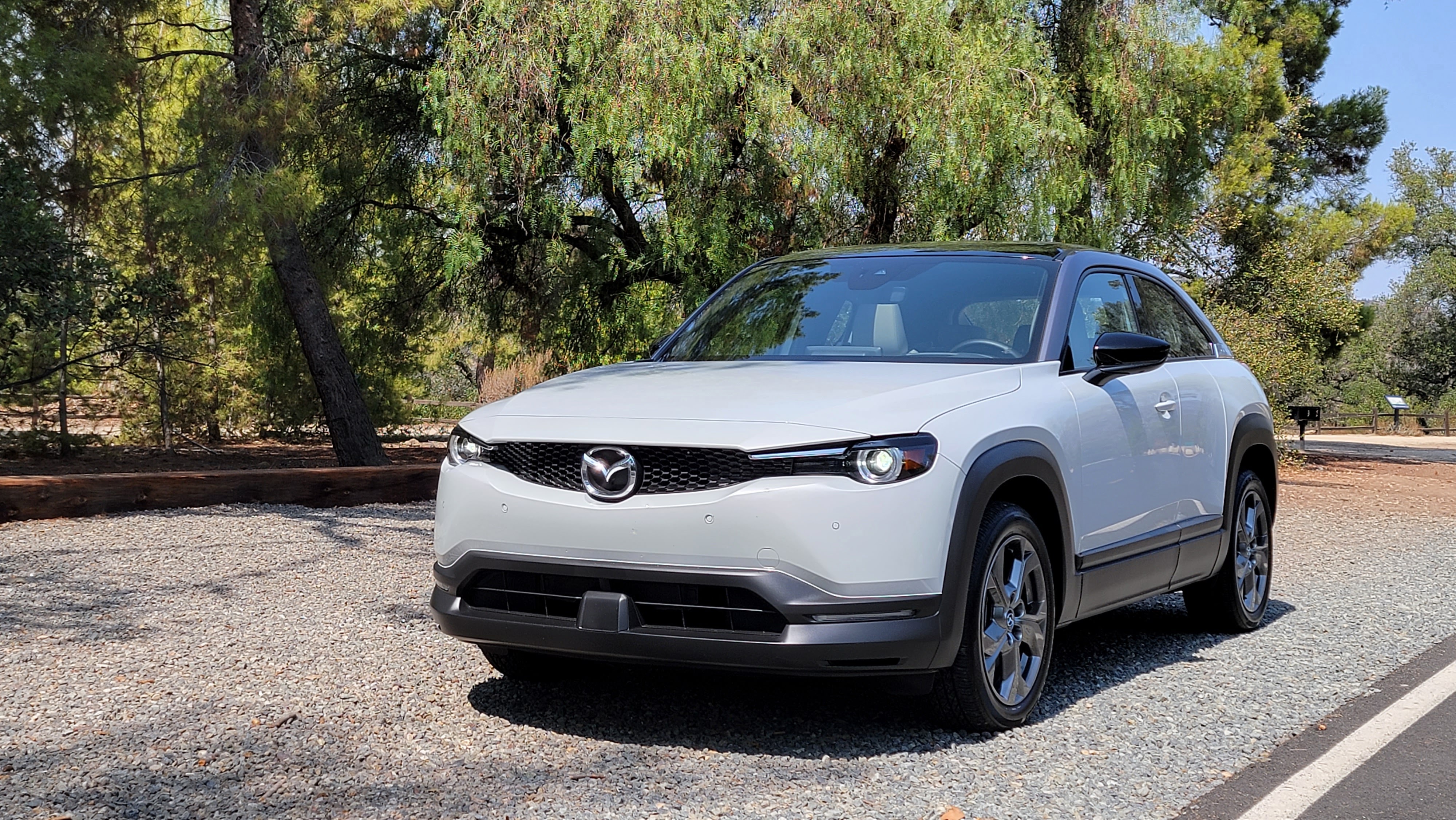
Did you know Mazda has a battery EV? After first coming to other markets, it's now available in the US. The Mazda MX-30 is a small "commuter" battery-electric crossover with a 100-mile (160km) EPA range.
Yes, one hundred miles - that’s not a typo. It's based on the CX-30 platform, and this year in the US, Mazda is only selling 560 of them, and only in California. If we were cynical, we'd replace "commuter" with "compliance".
Compliance cars were sold in California a decade ago to meet CARB (California Air Resource Board) emissions mandates and were basically existing ICE (Internal Combustion Engine) vehicles converted to battery EVs with a limited range (typically less than 100 miles).
These included the Fiat 500e, Chevrolet Spark EV, Ford Focus EV, Honda Fit EV, Toyota RAV4 EV and others, and were generally only available in California in limited numbers.
It's easy to dismiss the MX-30 on range alone, but Mazda insists there's more to the story. So we recently took this odd battery-electric crossover for a spin, and here are our first impressions.
Mazda MX-30 specs and features
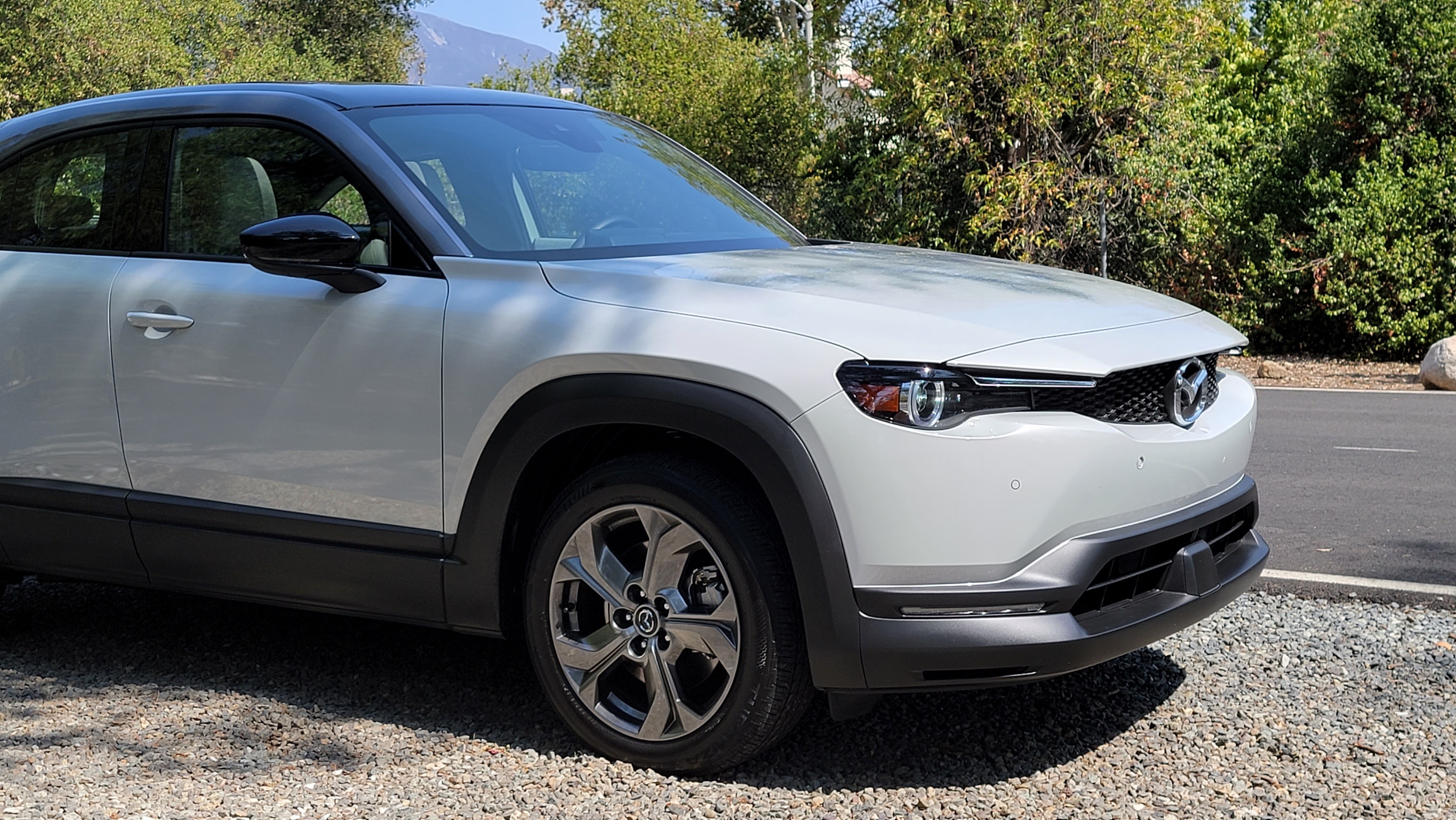
The MX-30 battery EV is built on the same platform as the CX-30 internal combustion crossover. Mazda basically shoehorned an 80.9kW electric motor over the front axle, and a 35.5kWh battery under the floor, in front of the rear axle.
This results in a FWD vehicle with a 40/60 (front/back) weight distribution - which is definitely unusual. The range is a meager 100 miles (160km) EPA, and 124 miles (199km) WLTP - the former being the industry standard test for North America, while the latter is European standard test.
Sign up for breaking news, reviews, opinion, top tech deals, and more.
With a curb weight of 3655lbs (1657kg), it's pretty light for an EV, but besides the paltry range, that electric motor only develops 143hp (107kW) and 200lb-ft (271Nm) of torque, resulting in a miserly 9.4-second 0-60mph sprint (0-100km/h in 9.7s).
If you're keeping track, that's slower than most ICE or hybrid crossovers sold in the US - including Mazda's own base model CX-30, which reaches 60mph in about 8 seconds.
In the US, the MX-30 is available in two trims: MX-30 EV ($33,470 before incentives) and Premium Plus ($36,480 before incentives).
Both come with LTE connectivity, a WiFi hotspot, Apple CarPlay and Android Auto, Pandora internet radio, a 150W 120V AC power outlet, a HUD (heads-up display), adaptive LED auto headlights, auto wipers, heated power seats with driver's memory, a power sunroof, a backup camera, and rear parking sensors.
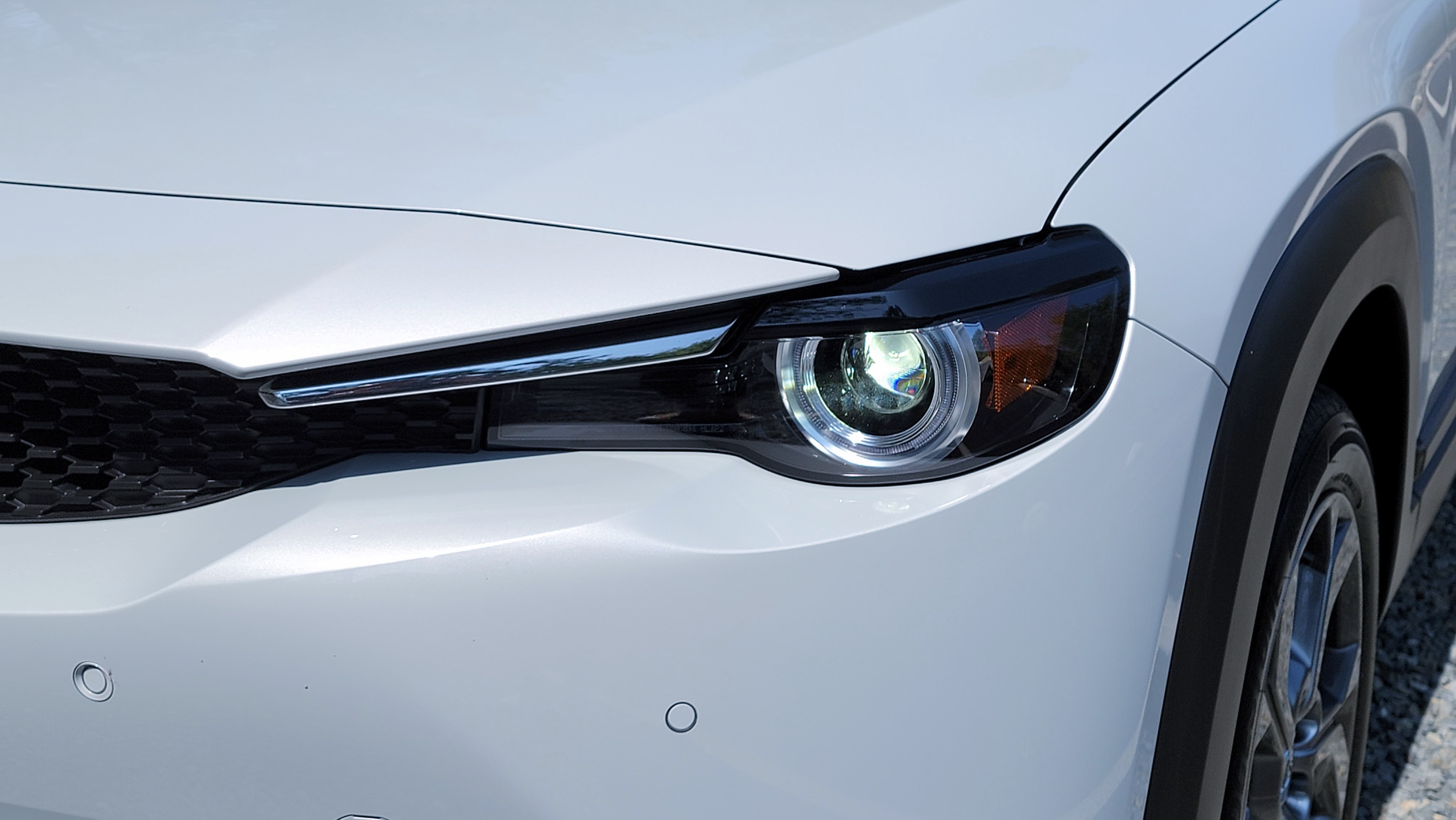
The Premium Plus package adds navigation, Bose premium audio, Sirius-XM satellite radio, a heated steering wheel, a 360-degree view, and front parking sensors. Both models also include adaptive cruise control plus Mazda's i-Activsense safety features (more on this later).
In the UK, the MX-30 comes in four variants priced between £26,045 and £30,345 - with the lowest trim positioned below the base model sold in the US.
A single trim is available in Australia. It costs AU$70,900 and is roughly equivalent to the Premium Plus package in the US.
The MX-30 supports 50kW DC fast charging (20-80% in 36 minutes) and 6.6kW AC charging (20-80% in 2h 50m) via a CCS combo connector. US customers get a $500 charging credit on the ChargePoint network, or a $500 discount towards the purchase of a ChargePoint Level 2 home charger.
In addition, the Elite Access Loaner Program lets US customers borrow other Mazda vehicles for up to 10 days per year during the first three years.
Mazda MX-30 tech
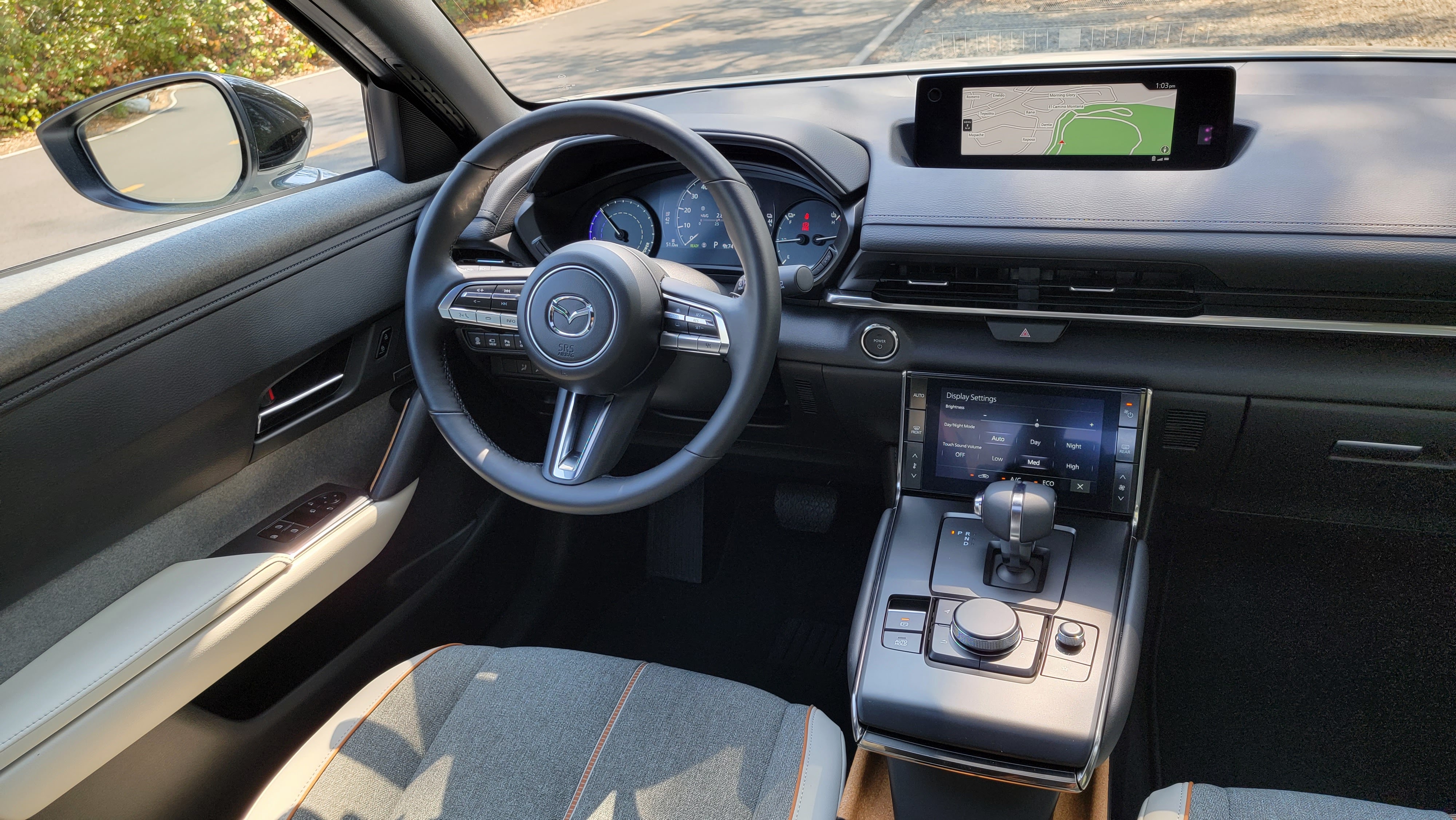
On the tech front, the MX-30 just covers the basics. There's no Level 2 ADAS (advanced driver assistance system) and no Qi wireless phone charging pad (it's a dealer-installed accessory). Even navigation is optional in the US, though it's standard with the Premium Plus package.
What you get is adaptive cruise control, a heads-up display, a pair of USB ports (one Type-A and one Type-C), and a 150W 120V AC power outlet.
The infotainment system features LTE connectivity, a WiFi hotspot, Bluetooth for audio and calls, (wired) Apple CarPlay and Android Auto, and Pandora internet radio.
Unfortunately, the dashboard-mounted 8.8-inch infotainment display isn't touch-sensitive, so you have to use a puck-like controller in the center console to navigate the user interface. Needless to say, this makes using Apple CarPlay and Android Auto a real chore.
A 7-inch touchscreen is located below the dashboard ahead of the center console, and controls the single-zone climate system. It's flanked by physical buttons on each side for direct access to the temperature, fan speed, and defroster adjustments.
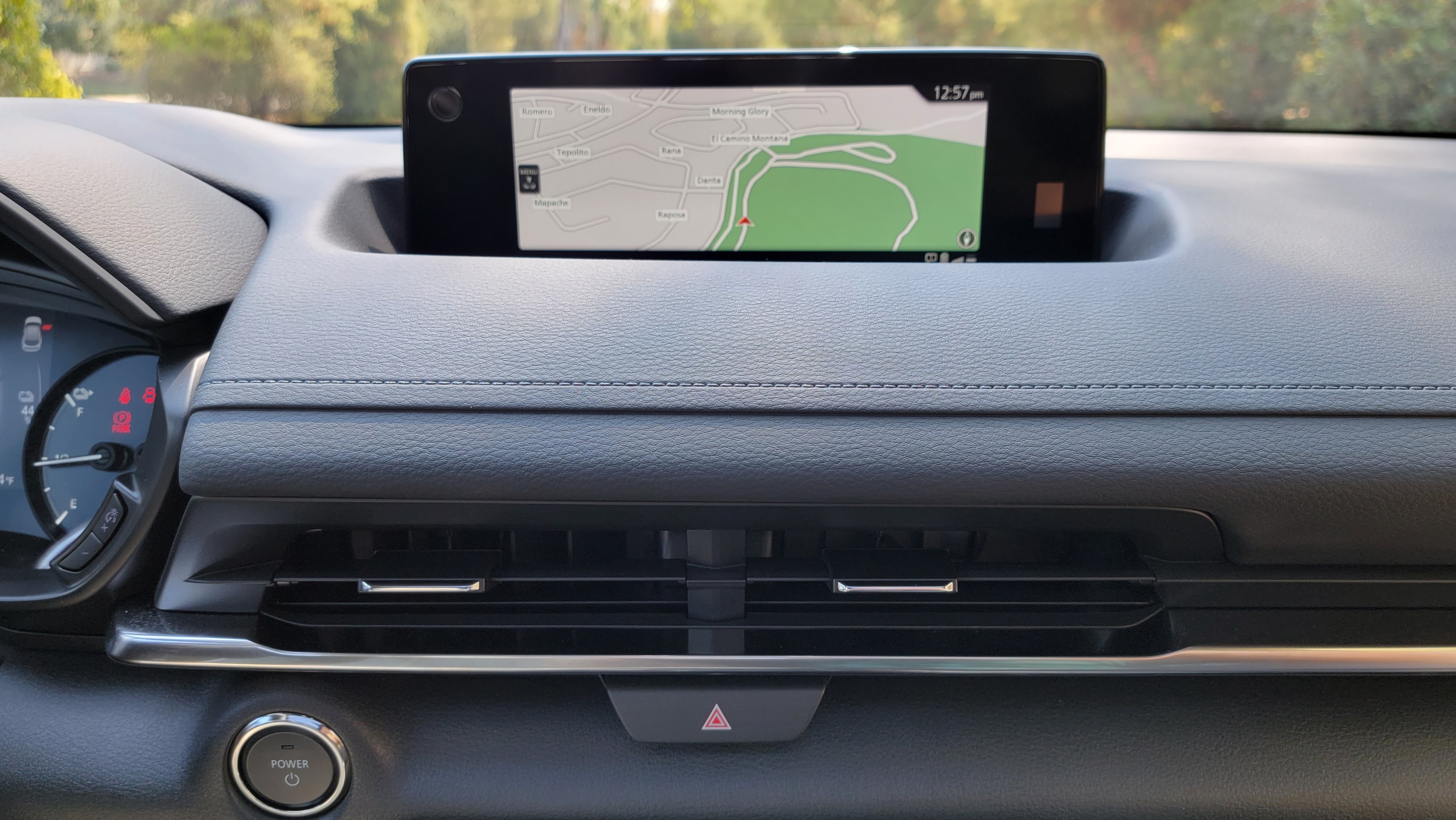
The instrument cluster features an analog power/regen dial on the left, a 7-inch display in the middle, and a pair of analog dials that show the battery level and temperature on the right.
It's a bit strange to see analog dials on an EV, but it suits this vehicle's character, so we'll allow it.
The 7-inch instrument display shows the speed (analog and digital), adaptive cruise control info, charging status, range, consumption, current gear, odometer, outside temperature, etc. - but there’s little for the driver to configure here.
The same goes for the 7-inch touchscreen in the middle, which really just controls the climate system.
Mazda's i-Activsense safety features are standard fare for a modern EV. These include forward collision warning and automatic emergency braking, lane departure warning and lane-keeping assist, blind spot monitoring and rear traffic alert, rear parking sensors, auto high-beams, and driver attention alert.
Move up to the Premium Plus trim, and you also get Homelink, a 360-degree view, front traffic alert, and front parking sensors.
LTE connectivity enables remote charging management and climate control via the MyMazda app, but the car doesn’t include phone-as-a-key functionality. The MX-30 comes with a familiar keyless entry fob instead.
Mazda MX-30 design
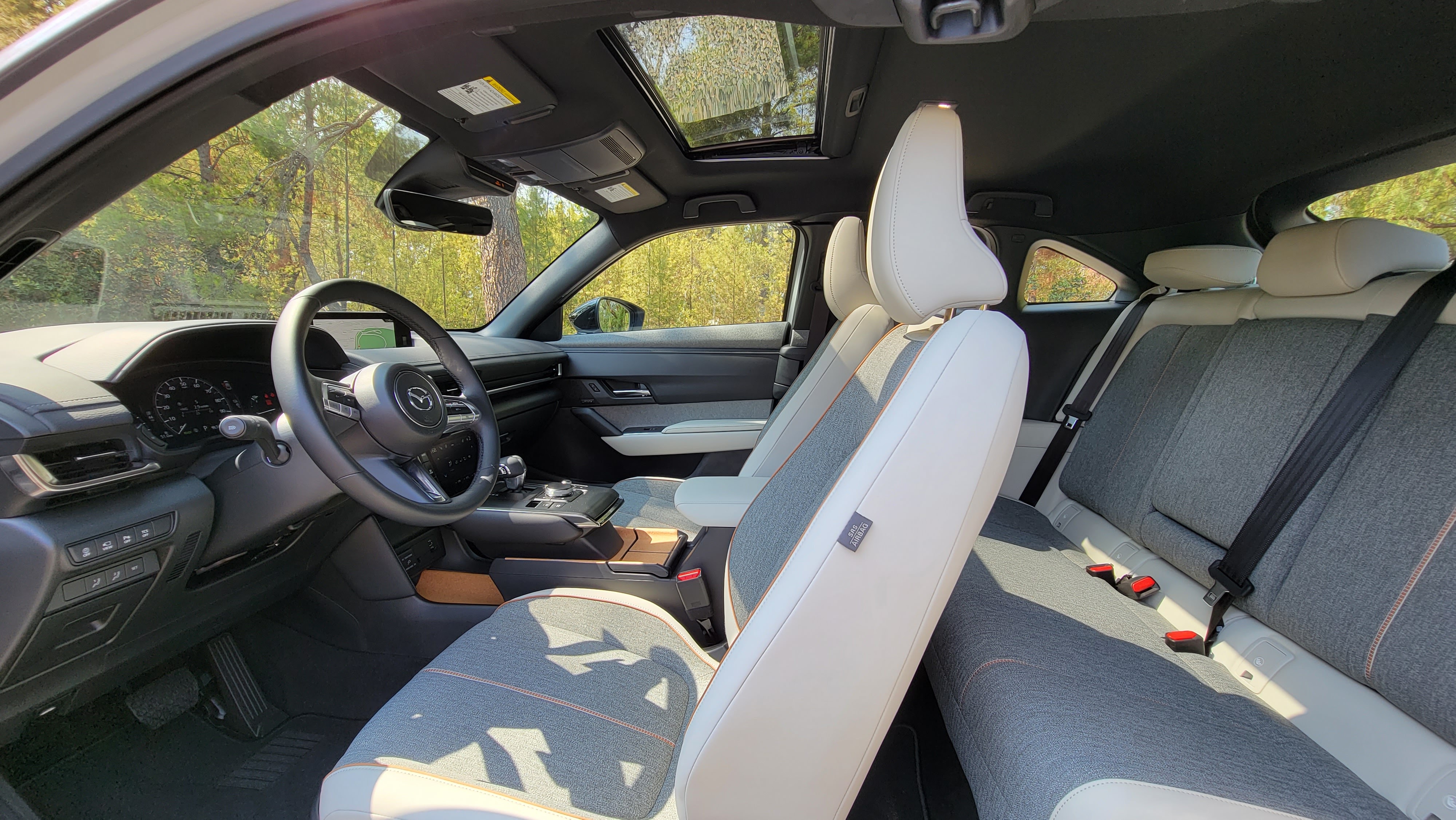
The exterior design of the MX-30 is best described as a hybrid between the CX-30 crossover and Mazda’s RX-8 sports car from a decade ago.
Basically, it's a small crossover with a coupé-like roofline and clamshell rear doors (which Mazda calls Freestyle doors). It's somewhat reminiscent of another short-range EV - the BMW i3. Unfortunately, while the CX-30 looks sleek, the MX-30 just looks awkward.
Besides this EV being yet another crossover, we're definitely not fans of those thick, rectangular, plastic-clad wheel arches. On the plus side, the MX-30 inherits the CX-30’s long hood, slender headlights, and Ferrari-inspired tail lights - but with a smaller grille.
Inside, it's a completely different story. The MX-30's interior design is modern and fresh, and boasts interesting materials - like cork and recycled PET bottles. We like it a lot.

Mazda started out as a cork manufacturer 100+ years ago, so it's a fitting material. The two-tone leatherette and cloth seat are comfortable, and the orange piping in our test car adds a lovely touch.
But what stands out most inside the MX-30 is the three-tiered center console, which appears to float between the seats. The top tier is home to the infotainment system’s puck-like controller, gear selector, and the 7-inch climate display.
In the middle tier, which is positioned further back, you’ll find two cup holders under separate cork-covered flaps. The lower tier (below the top tier) is a cork-covered storage tray that incorporates two USB ports (one Type-A and one Type-C) along with the 150W 120V AC power outlet.
There’s an armrest behind the cupholders, which lifts up to reveal a deep storage cubby. In all, this interior looks and feels great.
Behind the front seat is where the MX-30 falls short. The back seats are cramped, and the sloped roof cuts into both rear headroom and trunk space. Rear legroom is poor, and the freestyle doors make ingress and egress more difficult.
Trunk storage with the seats up is 21 cubic feet (594 liters) and the rear seats fold 60/40, but there’s no frunk - yet there’s quite a bit of empty space under the hood (bonnet).
It turns out this empty space is meant for a rotary engine-powered range extender Mazda plans to add to the MX-30 lineup next year.
Mazda MX-30 driving impressions
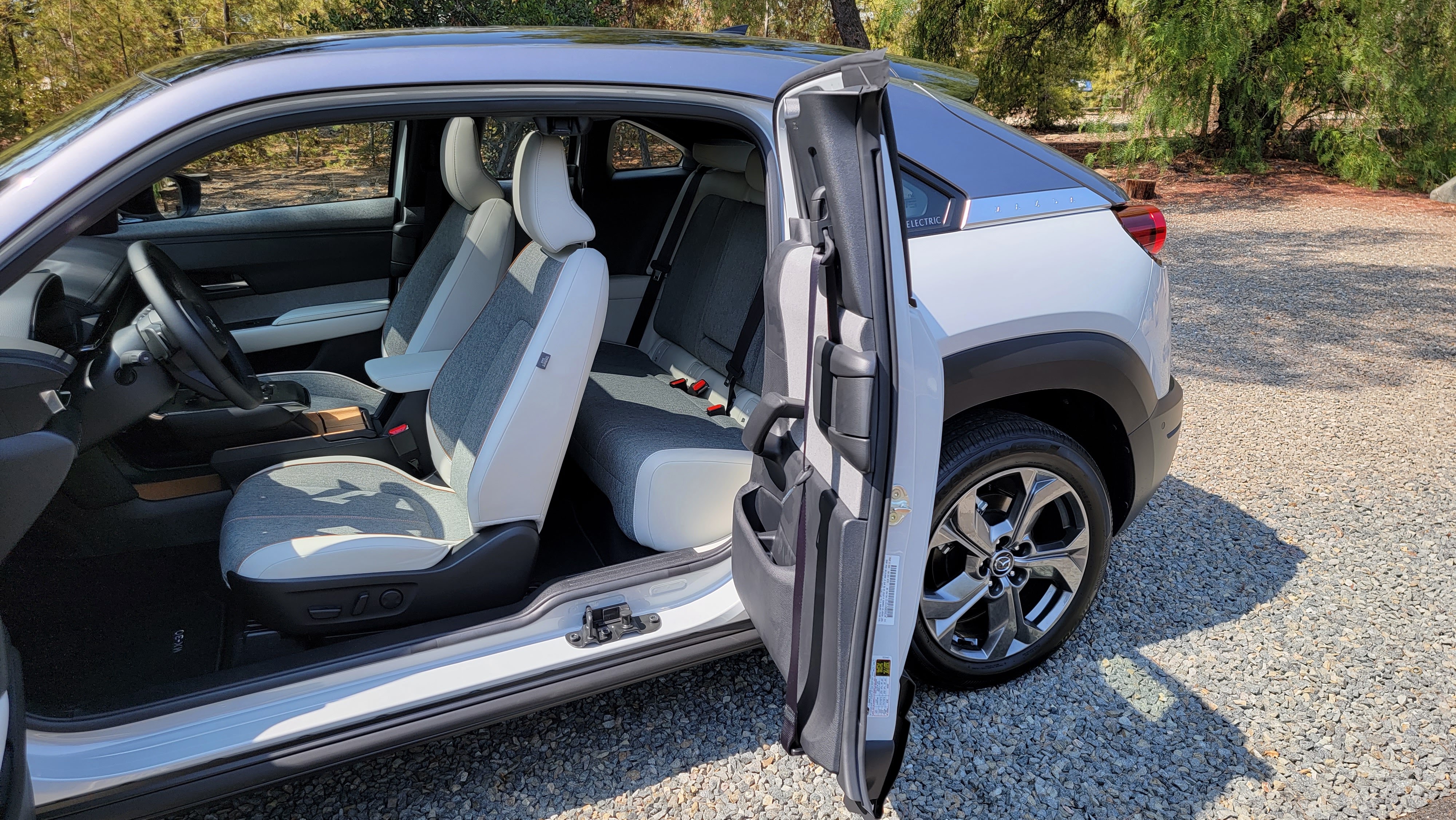
Driving the MX-30 is a mixed bag. The good news is Mazda's fun-to-drive DNA is alive and well. While this is no Miata/MX-5, handling is nimble and playful.
Obviously, the low center of gravity helps, but so does Mazda’s e-GVC, a torque-vectoring and weight-transfer system that basically trail-brakes for you. The ride is excellent too - stiff enough to feel sporty, yet compliant enough to be comfortable on a variety of road surfaces.
Steering is where the MX-30 shines. It's quick and precise, with just the right amount of weight, and it provides a decent amount of feedback - especially for an electric power steering setup on a FWD vehicle.
The brakes are also well sorted: Mazda is blending hydraulic and regen braking here, and it feels seamless. The MX-30 doesn't have drive modes, but the amount of regen is adjustable (5 levels) with steering wheel paddles.
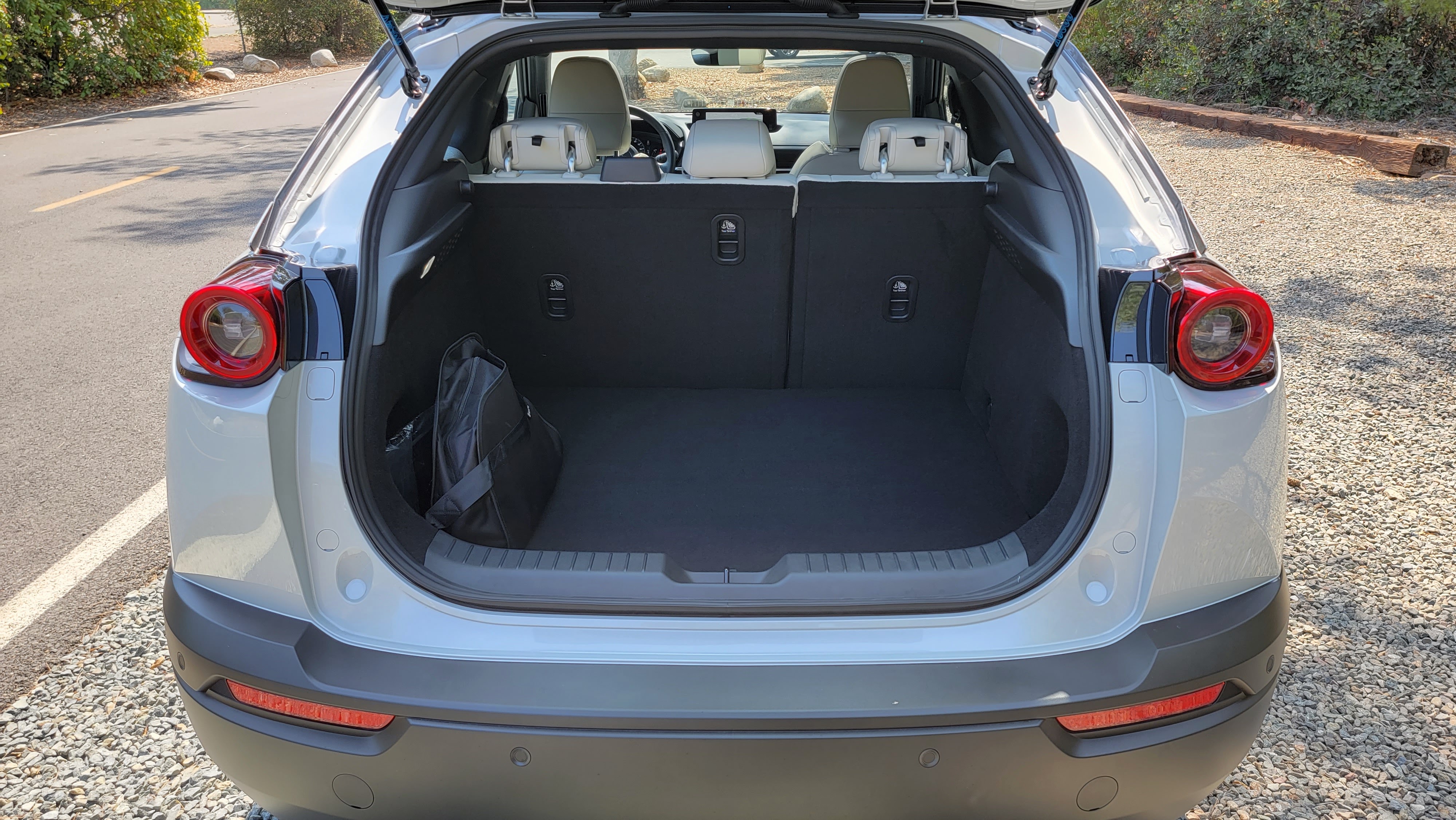
The seating position and ergonomics are top notch as well. Since this is a crossover, you’re seated slightly higher than in a standard car, but the slim, horizontal dashboard is low, so front visibility is excellent, and the sunroof adds to the sensation of space.
Also, while the analog instrument dials and the clunky gear selector seem anachronistic in an EV these days, we appreciate Mazda’s effort to keep the controls familiar.
Now for the bad news: its performance is extremely disappointing. One of the thrills of driving an EV is instant torque and strong acceleration, but with a 0-60mph time of 9.4 seconds, you get little of this experience here.
Mazda claims it tuned the MX-30’s electric drivetrain for "minimum jerk", but we think this is a copout. In the US market, 143hp and 200lb-ft simply isn't enough power and torque for a vehicle that weighs 3655lbs.
Still, our gut says that Mazda is holding back. The MX-30 should be able to achieve a faster 0-60mph time. But, for whatever reason - range, battery longevity - Mazda can't, or won't deliver more performance.
It's a real bummer. Who wants an EV with worse acceleration than an ICE car? Especially one with such limited range? It's one thing to make an EV for commuters, it’s another thing to cripple it with lackluster performance.
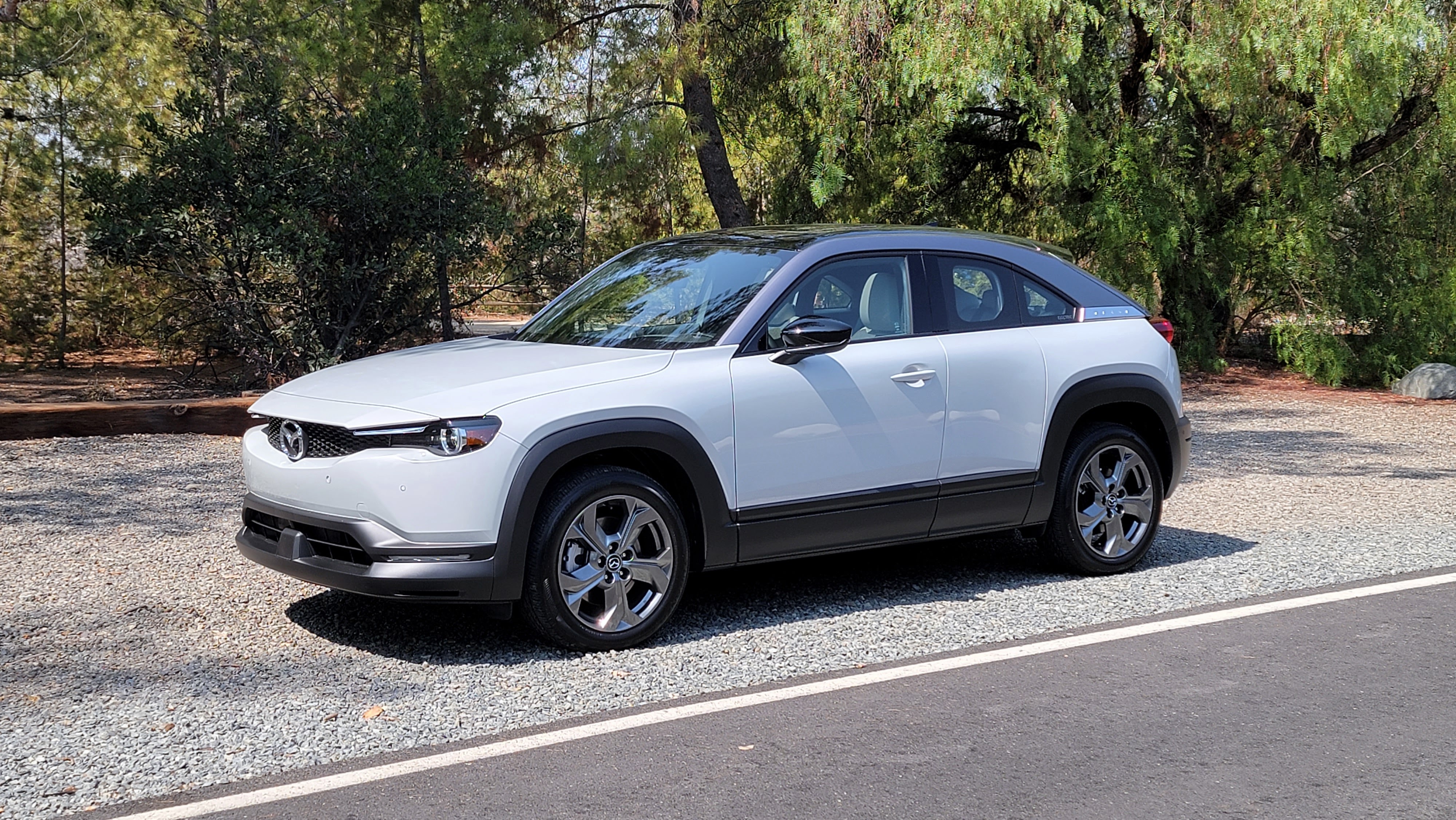
Then there’s the price. $33,470 before incentives puts the MX-30 in the same ballpark as the Nissan Leaf Plus, Hyundai Kona Electric, and Chevy Bolt, which are all faster and offer 226, 258, and 259 miles of range, respectively.
Or, if you're looking for a short range EV with more personality, the $29,900 Mini Cooper SE is a blast to drive. While it only delivers 110mi of range, it does the 0-60mph sprint in less than 7 seconds.
Ultimately, it’s hard not to see the MX-30 as anything but just another compliance car. We know Mazda can do better than this. After all, this is the company who brought us the delightful Miata/MX-5 and so many other great cars.
What the market needs is a battery-electric CX-30 with a 250-mile range and decent performance. But what we really want is a battery-electric MX-5 - after all, Miata is always the answer, right?

Myriam Joire (tnkgrl) was born wearing combat boots and holding a keyboard. Moments later she picked up a soldering iron. On weekends, she rally-raced with her father. She's been stomping, typing, hacking, and driving ever since. After spending years being a code-monkey in the video game industry, she joined Engadget as Senior Mobile Editor and later Pebble as Chief Evangelist. Today she hosts the weekly Mobile Tech Podcast, makes videos on YouTube, writes about tech and cars for TechRadar and other major publications, and advises startups on product/media strategy. She's based in San Francisco.